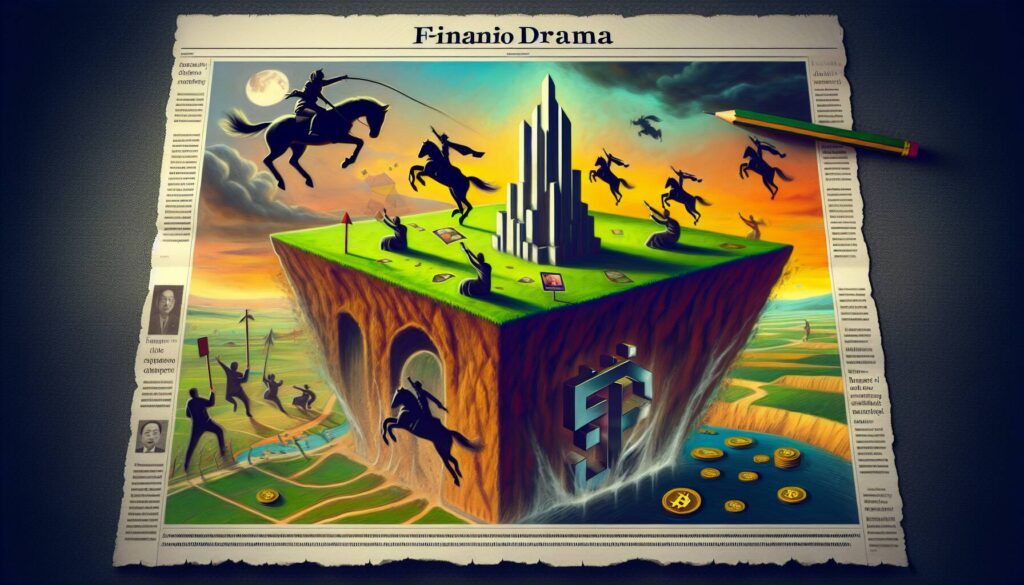The cryptocurrency market experienced a rollercoaster of activity recently, echoing broader trends in the stock market. In a whirlwind ninety minutes, the Nasdaq fluctuated quite dramatically—from a steep 5% loss to a remarkable 5% gain before ultimately settling back to neutral territory. This volatility was sparked by a rumor about President Trump contemplating a ninety-day delay in implementing tariffs for all nations except China, a claim that the White House quickly labeled as “fake news,” according to Press Secretary Caroline Leavitt.
This market uncertainty rippled through the crypto world, impacting major digital currencies. Bitcoin (BTC) saw its price leap from approximately $74,400 to over $80,000 before retreating back to around $79,000, marking a 4.3% dip over the last 24 hours. Ether (ETH), one of Bitcoin’s most notable counterparts, suffered even more, plummeting over 11%, while XRP faced a decline of 9.3%.
However, amidst this turmoil, there are glimmers of hope. European Union Commissioner Ursula von der Leyen stated, “Europe is ready to negotiate with the U.S.,” hinting at the potential for tariff discussions that could ease trade tensions. President Trump echoed this sentiment, noting that nations worldwide are actively engaging with the U.S., including Japan, which he claimed is sending a “top team” for negotiations.
As market participants keep a close eye on these developments, the interplay between cryptocurrency volatility and global trade negotiations remains a key focus for investors and analysts alike.

Market Volatility and Tariff Talks
The recent market fluctuations have created a wave of uncertainty, impacting both equities and cryptocurrencies. Here are the key points from the situation:
- Extreme Market Swings:
- Nasdaq experienced a dramatic shift from a 5% loss to a 5% gain.
- The return to flat indicates underlying instability within the market.
- Tariff Delay Rumors:
- The speculation about a 90-day delay on tariffs was officially denied by the White House, described as “fake news.”
- This kind of misinformation can lead to heightened market volatility and impact investor confidence.
- Impact on Cryptocurrencies:
- Bitcoin’s price fluctuated significantly, rising to over $80,000 before settling lower.
- Other cryptocurrencies, like Ether and XRP, also experienced notable declines.
- International Trade Talks:
- EU Commissioner Ursula von der Leyen expressed readiness to negotiate with the U.S. on tariffs.
- The proposal of “zero-for-zero” tariffs on industrial goods could signal a shift towards more favorable trade relations.
- Global Negotiations:
- President Trump stated that various countries are engaged in trade discussions, with Japan sending a “top team” for negotiations.
- This indicates potential for future trade agreements that could stabilize markets.
The outcomes of these negotiations and the resolution of tariff discussions can significantly impact both market stability and economic growth for individuals and businesses alike.
Market Volatility: Analyzing Recent Developments in Tariff and Cryptocurrency Trends
The recent fluctuations in the stock market, particularly the Nasdaq’s dramatic shift from significant losses to gains, have highlighted both the volatility and unpredictability that investors currently face. Notably, the abrupt change was primarily influenced by a rumor regarding President Trump’s potential tariff implementation delay, which was swiftly denied by the White House. This incident underscores a pivotal advantage for quick-thinking investors who thrive in chaotic environments, as they can capitalize on such swings. However, it also presents a substantial disadvantage; the market’s sensitivity to unverified news can lead to misguided decisions based on fear rather than fundamentals.
Comparing this situation to similar market responses in the past, we see echoes of the 2018 trade war tensions where speculative behavior based on government rhetoric created pronounced market inconsistencies. In those instances, sharp saner investing strategies often became overwhelmed by the emotionality of traders reacting to fast-paced news cycles. The ability of the market to rebound quickly could benefit agile traders, while those with a more conservative investment philosophy might find themselves rattled and uncertain.
This environment particularly favors day traders and those with a higher risk tolerance who can navigate the immediate volatility to seize opportunities. On the other hand, long-term investors may find this heightened uncertainty a liability, as over-reaction to tariff news can skew long-term valuations and undermine confidence. The cryptocurrency sector also experienced this ripple effect; as Bitcoin’s and Ether’s values fluctuated wildly, these asset classes once again illustrated their susceptibility to broader market trends, instilling further fear among general investors and traditional institutions.
Additionally, the positive sentiment stemming from hints of negotiations between the EU and the U.S. could potentially quell fears if taken to fruition, fostering a more stable trading environment. However, if negotiations falter or are delayed, it could exacerbate current market conditions, leading to even greater volatility. In this strategic landscape, those who are well-informed and can anticipate changes based on geopolitical movements will fare better, while those caught off-guard may face serious setbacks.
















